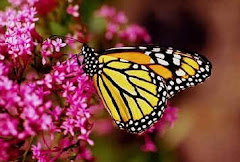
The Monarch Butterfly is the king of the insect world
The Monarch Butterfly's scientific name is Danaus Plexippus
Some of the Monarch Butterflies are poisonous
The Monarch Butterflies have a wingspan of 3 3/8 - 4 7/8 inches (8.6 - 12.4 cm)
The Monarch Butterflies have a life span of 8-9 months
The Monarch Butterfly eats milkweed as a caterpillar and eats nectar as an adult butterfly
The Monarch Butterfly breathes through its wings
Monarch Butterflies crossbreed with only their own kind
Monarchs are related to all milkweed eating butterflies
The Monarch Butterfly is also called a milkweed butterfly
People who study Monarch Butterflies are called Lepidopterists
Monarch Butterflies fly from between 5 to 30 miles an hour
The Monarch Butterfly can lay up to 500 eggs
Monarch Butterflies can overheat in hot climates
There are more than a dozen different types of milkweed
Only the Black Headed Grosbeak and the Black-Backed Orioles can eat the Monarch
Butterfly
Monarch Butterflies prefer highlands
The wings of the Monarch Butterflies tend to wear out from time to time
Monarchs do not travel at very high speeds
The Agent Orange that decreased the population of Monarchs in Vietnam cannot be removed from the soil
The only difference between the North American Monarchs and the Vietnamese Monarchs are the markings on their wings
Male Monarchs have a dark spot also known as scent scales and also small claspers at the end of their abdomen
Female Monarchs have thicker wing veins
The Aztec believed the adult Monarch Butterflies to be the incarnation of their fallen warriors, wearing the colors of battle
Monarch females can lay several hundred eggs, usually laying a single egg on a plant. The eggs hatch about four days after they are laid
Monarch larvae, like other caterpillars, have very poor vision. They see through six pairs of eyes called ocelli
The Monarch Butterfly is known by scientists as Danaus plexippus, which in Greek
literally means "sleepy transformation." The name, which means to hibernate and metamorphize, is inspired by the Greek myth of Danaus. In this story the daughters of Danaus, king of Libya, escape Libya and go to Greece in order to avoid marrying their cousins. The long migration of the Monarch Butterflies reminds us of the the daughters' flight.
The larvae feed on the plant leaves for about two weeks and develop into caterpillars about 2 inches long.
Monarchs use "thermals," or warm air, to allow them to glide as they migrate. This helps them conserve energy for their long flight. Migrating birds also use thermals.
~ Mark O'Lalor
source: http://www.tqnyc.org/









